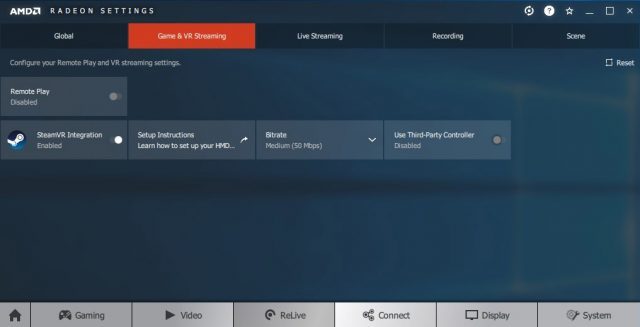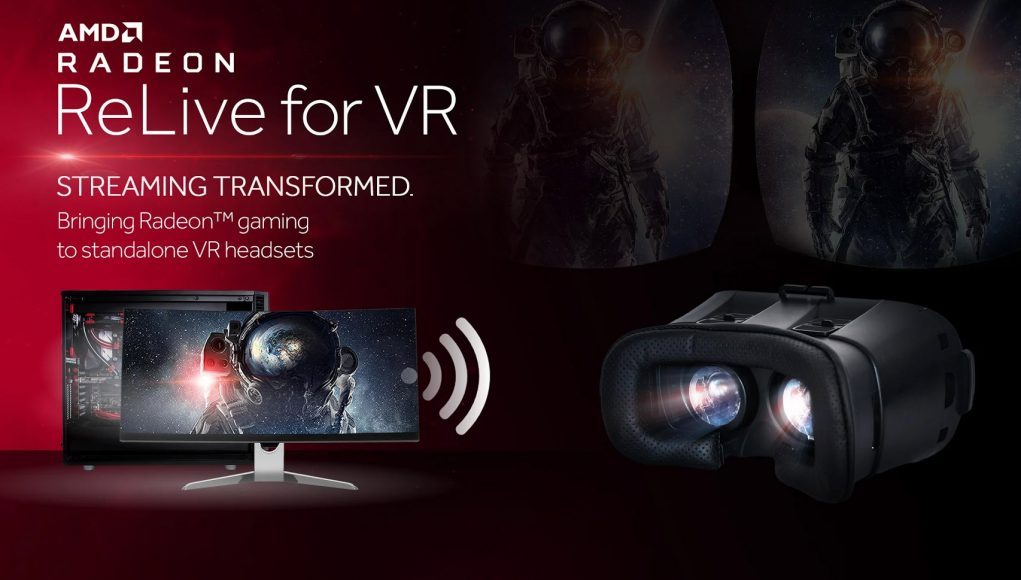AMD today launched an updated version of their AMD Radeon Software suite which now includes the ability to stream SteamVR games to standalone and smartphone-based headsets, assuming you have a compatible AMD GPU. But until mobile headsets support the full head/hand 6DOF input that PC VR apps expect, it’s potential is quite niche.
Launching at an odd time (well before any full 6DOF mobile headsets are available to consumers) is AMD’s Radeon ReLive for VR feature which promises to stream SteamVR games from your PC to mobile headsets with high quality and low latency.
The feature is baked into the latest release of the increasingly wordy AMD Radeon Software Adrenalin 2019 Edition, and is backed up by a Radeon ReLive for VR app available currently on Vive Focus and Daydream devices, though eventually coming to Oculus Go and Samsung Gear too, according to an AMD spokesperson.
To use the VR streaming feature, you’ll need a modern AMD GPU (specifically RX 470, RX 570, RX 480, RX 580, RX 590 or RX Vega series). You’ll also need Windows 10 and an 802.11ac (5GHz) router.
Once you’ve downloaded the companion app and connected it to your PC, you’ll be able to use your headset to control SteamVR, at least the part of it which are compatible with the input devices you have on hand.

Since almost all SteamVR titles are built with the expectation of full 6DOF tracking on head and hands, it’s easy to see why you won’t be playing Beat Saber, Superhot VR, or Budget Cuts any time soon on your Vive Focus or Mirage Solo—both have 6DOF head tracking but currently only offer a single 3DOF controller. Both headsets have development kits which add support for a pair of 6DOF controllers, but neither are available to consumers at this point.
For Radeon ReLive for VR, that currently leaves only a handful of decent VR games which can be played with pure gamepad input (which can come through the PC or via Bluetooth through the headset), the likes of Project Cars 2 (2017), Elite Dangerous (2015), and other simulator-focused titles. But there’s also Skyrim VR (2018) which carries gamepad support over from the PSVR version, and a few other gamepad supported gems like Keep Talking and Nobody Explodes (2015), Thumper (2016), and Vox Machinae (2018).
Kevin Carbotte from Tom’s Hardware went hands on with the Radeon ReLive for VR feature, testing it with the 2017 Daydream headset, Pixel 2 XL, and Radeon RX Vega 64. He found that the solution technically works, despite a few hitches in game initialization, and offers “sufficient” image quality at the default 50 Mbps bitrate without adding noticeable latency. When testing at 100 Mbps he found the resultant image sharp but too choppy for play. The 2 Mbps setting, on the other hand, was so low quality that Carbotte said it shouldn’t even have been included.
Carbotte summed up the current niche usefulness of ReLive for VR quite nicely:
If you’re one of the few people who [has everything else on this list but] doesn’t have a PC VR headset, already own a mobile VR headset, already possess a modern Radeon graphics card and have no interest in room-scale VR games, then ReLive for VR is perfect for you. If you don’t fit into the small box, you probably won’t have much use for this new Radeon feature.
Of course, assuming it works well, it’ll be more useful once there’s standalone headsets out there which have full 6DOF tracking on head and hands, which will unlock the ability to play a much broader number of VR titles with the feature. Oculus Quest, which includes full 6DOF tracking, is set to launch in early 2019 and will ostensibly be the first such device supported by Radeon ReLive for VR, though AMD hasn’t specifically confirmed support for it just yet.







